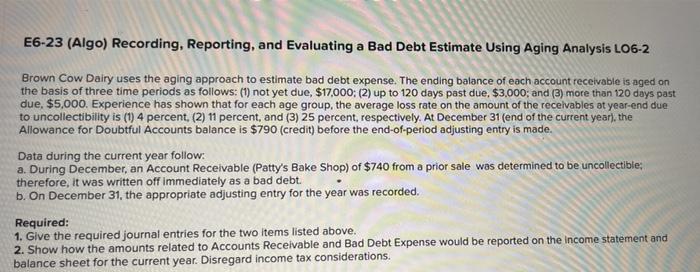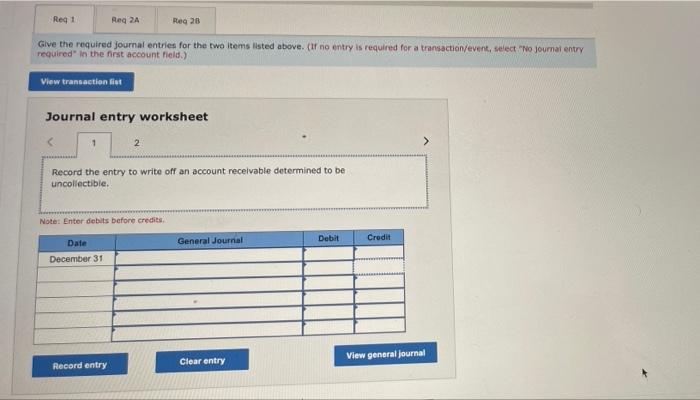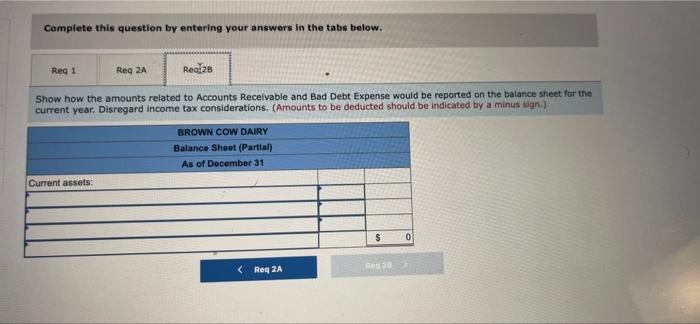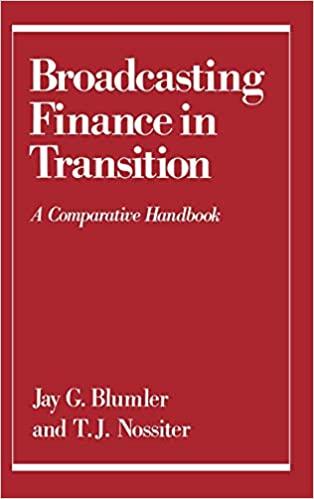Answered step by step
Verified Expert Solution
Question
1 Approved Answer
E6-23 (Algo) Recording, Reporting, and Evaluating a Bad Debt Estimate Using Aging Analysis LO6-2 Brown Cow Dairy uses the aging approach to estimate bad debt




 E6-23 (Algo) Recording, Reporting, and Evaluating a Bad Debt Estimate Using Aging Analysis LO6-2 Brown Cow Dairy uses the aging approach to estimate bad debt expense. The ending balance of each account receivable is aged on the basis of three time periods as follows: (1) not yet due, $17,000; (2) up to 120 days past due, $3,000; and (3) more than 120 days past due, $5,000. Experience has shown that for each age group, the average loss rate on the amount of the receivables at year-end due to uncollectibility is (1) 4 percent, (2) 11 percent, and (3) 25 percent, respectively. At December 31 (end of the current year), the Allowance for Doubtful Accounts balance is $790 (credit) before the end-of-period adjusting entry is made. Data during the current year follow: a. During December, an Account Receivable (Patty's Bake Shop) of $740 from a prior sale was determined to be uncollectible; therefore, it was written off immediately as a bad debt. b. On December 31, the appropriate adjusting entry for the year was recorded. Required: 1. Give the required journal entries for the two items listed above. 2. Show how the amounts related to Accounts Receivable and Bad Debt Expense would be reported on the income statement and balance sheet for the current year. Disregard income tax considerations. Req 1 Reg 24 Reg 28 Give the required journal entries for the two items listed above. (If no entry is required for a transaction/event, select "No journal entry required in the first account field.). View transaction list Journal entry worksheet Record the entry to write off an account receivable determined to be uncollectible. Note: Enter debits before credits. General Journal Debit Date December 31 Record entry Clear entry Credit View general journal Journal entry worksheet 2 Record the entry for bad debt expense. Note: Enter debits before credits. Date December 31 Record entry General Journal Clear entry Debit Credit View general journal Req 1 Req 2A Req 28 Show how the amounts related to Accounts Receivable and Bad Debt Expense would be reported on the income statement for the current year. Disregard Income tax considerations. BROWN COW DAIRY Income Statement (Partial) For the Year Ended December 31 Operating expenses: Req 28 > $
E6-23 (Algo) Recording, Reporting, and Evaluating a Bad Debt Estimate Using Aging Analysis LO6-2 Brown Cow Dairy uses the aging approach to estimate bad debt expense. The ending balance of each account receivable is aged on the basis of three time periods as follows: (1) not yet due, $17,000; (2) up to 120 days past due, $3,000; and (3) more than 120 days past due, $5,000. Experience has shown that for each age group, the average loss rate on the amount of the receivables at year-end due to uncollectibility is (1) 4 percent, (2) 11 percent, and (3) 25 percent, respectively. At December 31 (end of the current year), the Allowance for Doubtful Accounts balance is $790 (credit) before the end-of-period adjusting entry is made. Data during the current year follow: a. During December, an Account Receivable (Patty's Bake Shop) of $740 from a prior sale was determined to be uncollectible; therefore, it was written off immediately as a bad debt. b. On December 31, the appropriate adjusting entry for the year was recorded. Required: 1. Give the required journal entries for the two items listed above. 2. Show how the amounts related to Accounts Receivable and Bad Debt Expense would be reported on the income statement and balance sheet for the current year. Disregard income tax considerations. Req 1 Reg 24 Reg 28 Give the required journal entries for the two items listed above. (If no entry is required for a transaction/event, select "No journal entry required in the first account field.). View transaction list Journal entry worksheet Record the entry to write off an account receivable determined to be uncollectible. Note: Enter debits before credits. General Journal Debit Date December 31 Record entry Clear entry Credit View general journal Journal entry worksheet 2 Record the entry for bad debt expense. Note: Enter debits before credits. Date December 31 Record entry General Journal Clear entry Debit Credit View general journal Req 1 Req 2A Req 28 Show how the amounts related to Accounts Receivable and Bad Debt Expense would be reported on the income statement for the current year. Disregard Income tax considerations. BROWN COW DAIRY Income Statement (Partial) For the Year Ended December 31 Operating expenses: Req 28 > $





Step by Step Solution
There are 3 Steps involved in it
Step: 1

Get Instant Access to Expert-Tailored Solutions
See step-by-step solutions with expert insights and AI powered tools for academic success
Step: 2

Step: 3

Ace Your Homework with AI
Get the answers you need in no time with our AI-driven, step-by-step assistance
Get Started


